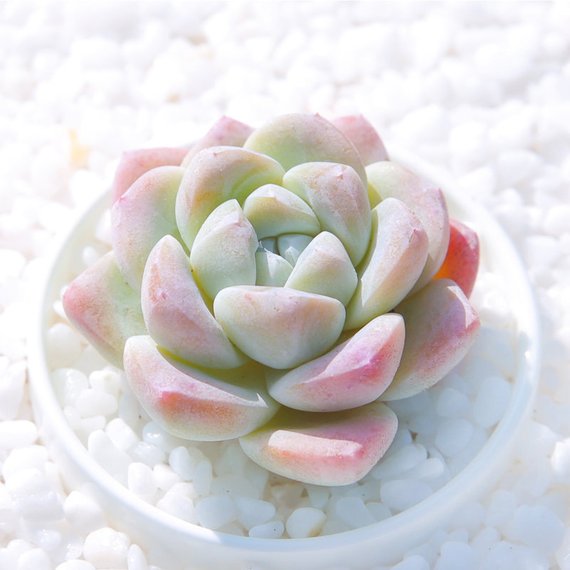Echeveria 'Ice green', a hybrid of Crassula ovata and Sedum nussbaumerianum, belongs to the Crassulaceae family of succulents. True to its name, in autumn and winter, under proper care, Echeveria 'Ice green' becomes plump and hydrated, transitioning from gray-green to red and orange-red colors, with a strong translucent luster, resembling finely carved jade artwork.
The beauty of Echeveria 'Ice green' in autumn and winter is dependent on proper care. Many plant enthusiasts have encountered issues like incomplete color changes and leaf blackening during Echeveria 'Ice green' care. Today, I will share a few tips on caring for Echeveria 'Ice green' to help you achieve optimal conditions during autumn and winter.
1. Proper Watering and Avoiding Watering on Leaves:
Almost all succulents need reduced watering in late autumn, and Echeveria 'Ice green' is no exception. Excessive watering stimulates leaf growth, leading to nutrient depletion in older leaves, resulting in thinning, fading, and even failure to change color. Late autumn, with significant day-night temperature differences, is crucial for Echeveria 'Ice green''s color transformation. Frequent watering at this time may compromise its crystalline jade-like texture, diminishing its aesthetic appeal.
During autumn and winter, Echeveria 'Ice green' should be watered moderately, with the soil kept slightly dry. If the temperature ranges from 5 to 10 degrees Celsius, and Echeveria 'Ice green' is semi-dormant or fully dormant, watering frequency should be reduced to once every two months.
Echeveria 'Ice green''s leaves have a thin layer of white powder that serves as protection. When watering, avoid wetting the leaves to prevent washing off the powder, which reduces the plant's disease resistance and increases susceptibility to infections.
2. Ensure Adequate Sunlight:
Echeveria 'Ice green''s compact leaf structure leaves minimal space between leaves, resulting in poor internal ventilation, which creates conditions for black rot disease. Black rot is a fungal infection that causes leaf blackening and rotting. To prevent black rot, besides ensuring proper ventilation and occasional fungicide spraying, adequate sunlight is crucial.
Sunlight and UV rays have excellent sterilizing effects. Keeping Echeveria 'Ice green' in dark areas for extended periods fosters the growth of various pathogenic bacteria, leading to diseases. During autumn and winter, Echeveria 'Ice green' should receive ample sunlight from morning till evening. The UV rays during these seasons are gentle, posing no risk of sunburn. Sufficient sunlight not only reduces disease incidence but also enhances leaf coloration.
3. Improve Ventilation and Prevent Freezing:
Maintaining environmental ventilation is essential to prevent black rot. Rooms or balconies housing Echeveria 'Ice green' need regular ventilation to ensure fresh air circulation. However, while ventilating, precautions should be taken to prevent freezing. Echeveria 'Ice green''s cold tolerance is relatively weak, with leaf damage occurring below 5 degrees Celsius. Therefore, during autumn and winter care, the ambient temperature should not drop below 5 degrees Celsius. When ventilating, avoid placing Echeveria 'Ice green' near drafty areas to prevent frostbite caused by cold outdoor air currents.
